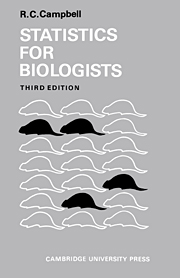Book contents
- Frontmatter
- Contents
- PREFACE
- PREFACE TO SECOND EDITION
- PREFACE TO THIRD EDITION
- 1 WHAT IS STATISTICS ABOUT?
- 2 PRESENTING THE INFORMATION CONTAINED IN ONE SAMPLE
- 3 COMPARING SEVERAL SAMPLES
- 4 ASSOCIATION
- 5 CHOOSING BETWEEN ACTIONS
- 6 THE NORMAL DISTRIBUTION
- 7 THE NORMAL VARIABLE IN EXPERIMENTS AND SURVEYS
- 8 ASSOCIATED NORMAL VARIABLES
- 9 SOME NON-NORMAL DISTRIBUTIONS
- FURTHER READING
- REFERENCES
- APPENDIX: TABLES AND FIGURES FOR STATISTICAL TESTS AND EXERCISES
- INDEX
9 - SOME NON-NORMAL DISTRIBUTIONS
Published online by Cambridge University Press: 05 June 2012
- Frontmatter
- Contents
- PREFACE
- PREFACE TO SECOND EDITION
- PREFACE TO THIRD EDITION
- 1 WHAT IS STATISTICS ABOUT?
- 2 PRESENTING THE INFORMATION CONTAINED IN ONE SAMPLE
- 3 COMPARING SEVERAL SAMPLES
- 4 ASSOCIATION
- 5 CHOOSING BETWEEN ACTIONS
- 6 THE NORMAL DISTRIBUTION
- 7 THE NORMAL VARIABLE IN EXPERIMENTS AND SURVEYS
- 8 ASSOCIATED NORMAL VARIABLES
- 9 SOME NON-NORMAL DISTRIBUTIONS
- FURTHER READING
- REFERENCES
- APPENDIX: TABLES AND FIGURES FOR STATISTICAL TESTS AND EXERCISES
- INDEX
Summary
Non-normal distributions
In the preceding chapters we have considered either methods applicable to all types of distribution or, in chapters 6, 7 and 8, methods applicable to one particular family of distributions, the normal family. The purpose of the present chapter is to discuss certain cases where the distribution of the variable under study is not normal but is nevertheless specified in a way which makes invalid the use of the non-parametric methods considered earlier.
Non-normal families of distributions can occur in many different forms, each characterized by particular circumstances and conditions of experimentation; in the present chapter we shall give most attention to two of the more important, the binomial and Poisson families. The binomial distribution has already been mentioned briefly in the discussion of the sign test (3.4.1.2); the Poisson distribution is a special case of it. We shall consider first the conditions under which these distributions occur.
The binomial and Poisson families
A distribution belonging to one of these families may occur when the experimental situation obeys the following three conditions:
(a) that for any one observation only two results are possible;
(b) that the chances of these two results do not vary from one observation to the next;
(c) that successive observations are independent in the sense of 4.2.3.
Condition (a) limits the relevance of these distributions to the cases where taking an observation can have only an ‘all-or-nothing’ result; thus a child who is exposed to the risk of measles either does or does not contract the disease;
- Type
- Chapter
- Information
- Statistics for Biologists , pp. 351 - 399Publisher: Cambridge University PressPrint publication year: 1989



